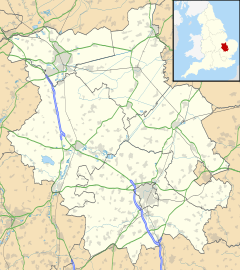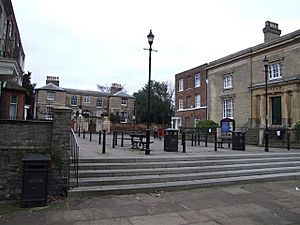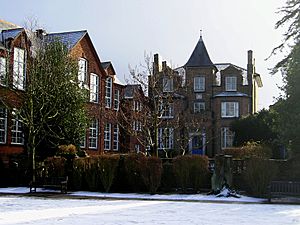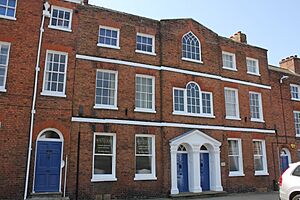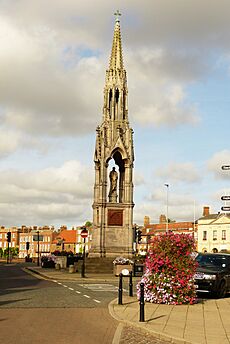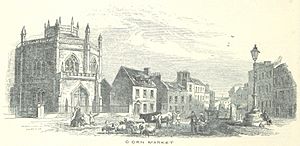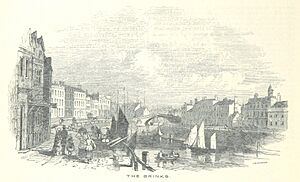Wisbech facts for kids
Quick facts for kids Wisbech |
|
|---|---|
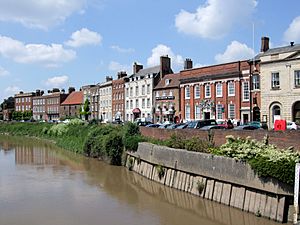 The North Brink |
|
| Population | 31,573 (2011) |
| OS grid reference | TF4609 |
| Civil parish |
|
| District |
|
| Shire county | |
| Region | |
| Country | England |
| Sovereign state | United Kingdom |
| Post town | WISBECH |
| Postcode district | PE13, PE14 |
| Dialling code | 01945 |
| Police | Cambridgeshire |
| Fire | Cambridgeshire |
| Ambulance | East of England |
| EU Parliament | East of England |
| UK Parliament |
|
Wisbech (pronounced WIZ-beech) is a busy market town and inland port in Cambridgeshire, England. In 2011, about 31,573 people lived there. The town is in the far north-east of Cambridgeshire, close to Norfolk and Lincolnshire.
The River Nene flows through Wisbech, with two road bridges crossing it. Wisbech is often called "the Capital of The Fens" because of its location in the Isle of Ely area. The town is famous for its beautiful Georgian architecture. You can see great examples along the North Brink, including Peckover House, which is a National Trust property. The Crescent is also a lovely area around Wisbech Castle.
Contents
- History of Wisbech
- How Wisbech is Governed
- Getting Around Wisbech
- People of Wisbech
- Wisbech's Economy
- Places of Worship
- Education in Wisbech
- Sports in Wisbech
- Culture and Arts
- Buildings and Architecture
- Famous People from Wisbech
- Wisbech in Media
- Climate in Wisbech
- Twin Town
- Images for kids
- See also
History of Wisbech
What's in a Name?
The name "Wisbech" was first written down in the year 656 as Wisbeach. It also appeared in the 1086 Domesday Book with the same spelling. Some people think the name means "on the back of the (River) Ouse." The word "Ouse" is an old Celtic word for water. Another idea is that the name comes from the River Wissey, which used to flow to Wisbech. This would mean "the valley of the River Wissey." Over time, the spelling changed many times until the local council decided on "Wisbech" in the 1800s.
Ancient Times
Long ago, during the Iron Age, the area where Wisbech now stands was part of the Iceni tribe's land. These were ancient Britons. Coins from the Iceni tribe have been found in Wisbech and nearby March.
Anglo-Saxon Era
Like the rest of Cambridgeshire, Wisbech was part of the Anglo-Saxon Kingdom of East Anglia. It was an important port on The Wash, a large bay on England's east coast. One of the earliest records of Wisbech is from 664. It mentions land in Wisbech being given to the Abbey at Peterborough.
Norman Times and Beyond
A famous local story from around the time of the Norman Invasion is about Tom Hickathrift, also known as the Wisbech Giant. In 1086, Wisbech was a large village with about 65 to 70 families. Some were farmers, and others were fishermen.
William the Conqueror built a castle in Wisbech to protect the area. Later, Richard I gave Wisbech a special charter. This meant residents didn't have to pay tolls at markets across England. King John of England visited the castle in 1216. Legend says his treasure was lost in the incoming tide of The Wash nearby. People still look for it today!
In 1236, a big sea flood hit Wisbech. Many people and animals were lost, and the castle was destroyed. But it was rebuilt by 1246. King Edward II visited Wisbech several times in the late 1200s and early 1300s. Wisbech Grammar School is very old, dating back to at least 1379.
Early Modern Period
Edward IV visited Wisbech in 1469. In 1549, Wisbech officially became a borough with a special charter from Edward VI. This gave the town more self-governance. Around this time, a lot of bricks were made in Wisbech. The town also had several fisheries.
During the 1500s and 1600s, Wisbech Castle was used as a prison for important people. In 1620, some former Wisbech residents, William White and Dorothea Bradford, sailed on the Mayflower to the New World. Dorothea's husband, William Bradford, later became a governor there.
English Civil War
During the English Civil War, Wisbech was close to the fighting. The town and castle were made ready for battle. Local troops from Wisbech even helped in the Siege of Crowland in 1642. The town was important because it controlled the route between Lincolnshire and Norfolk. A town library was started around 1653.
The 1700s
In the 1700s, Wisbech had soap manufacturers and its first workhouse, which opened in 1722.
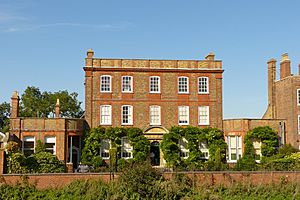
Peckover House, built in 1722, was bought by the Quaker Peckover banking family in the 1790s. Today, it's a National Trust property. The draining of the Fens made Wisbech a rich port. It handled farm goods, and many of the town's beautiful buildings come from this time.
The River Great Ouse used to flow through Wisbech, but as the coast changed, the River Nene was redirected to serve the town. In 1781, the Wisbech Literary Society was formed. A new theatre, now part of the Angles Theatre, was built around 1790.
The 1800s
The 1800s were a busy time for Wisbech. The first Wisbech Regatta was held in 1850. In 1858, Queen Victoria gave Wisbech a Russian Gun as a trophy from a war. The Isle of Ely and Wisbech Advertiser newspaper started in 1845.
The Wisbech & Fenland Museum opened in 1847. It still collects and shares the history of Wisbech. In 1848, the railway station opened, connecting Wisbech to other towns. Sadly, it closed in 1968.
In 1854, a serious cholera outbreak caused many deaths in Wisbech. This led to big improvements in the town's sewerage and water systems. New public buildings like the Exchange Hall and Public Hall were built for events. In 1857, there was a riot in the town, with people breaking windows and demanding money.
The Wisbech Working Men's Club and Institute started in 1864 and is one of the oldest in England. In the same year, the Castle estate was bought by Alexander Peckover. The Wisbech and Upwell Tramway opened in 1883, helping transport goods. It closed in 1966. The Wisbech Standard newspaper began in 1888.
The 1900s
In 1904, electric street lighting was installed in Wisbech. In 1913, there was civil unrest after a popular doctor died, leading to a crowd smashing windows. The Wisbech Canal was filled in to create a dual carriageway. The Wisbech War Memorial was unveiled in 1921.
In 1929, the Wisbech Pageant, a big historical show, attracted over 25,000 people. The Wisbech Society and Preservation Trust was founded in 1939 to protect the town's history. In 1949, the borough celebrated its 400th anniversary with another pageant.
The first Wisbech Rose Fair was held in 1963. Local rose growers sold rose buds to help restore the parish church. The next year, Wisbech became a twin town with Arles in France. In 1975, the first purpose-built council-run caravan site for travellers in the UK was built here.
In 1979, two Harrier jump jets crashed over Wisbech during a training exercise. One landed in a residential area, sadly causing three deaths. A new bypass for the A47 opened in 1982, helping traffic flow around the town. The Horsefair shopping centre opened in 1988.
Wisbech Today
In 2009, archaeologists dug at Wisbech Castle to find remains of the old Bishop's Palace. Many local volunteers and children took part. This led to the formation of the Fenland Archaeological Society (FenArch).
Work has been done to improve old buildings in the town, especially on Wisbech High Street. The Wisbech & Fenland Museum also had its roof replaced and reopened in 2022. Wisbech is known for its horticulture (gardening and growing plants). In 2018 and 2019, the town won gold awards in the Britain in Bloom competition.
How Wisbech is Governed
Wisbech has three levels of local government:
- Wisbech Town Council: This is the local council for the town itself. They manage things like allotments (small plots of land for growing food) and the market place. They are based at Wisbech Town Hall.
- Fenland District Council: This council covers the wider Fenland area, including Wisbech.
- Cambridgeshire County Council: This is the largest council, covering all of Cambridgeshire.
These councils work together to run local services.
A Look at Wisbech's Past Government
Wisbech was once a feudal village within the Wisbech hundred (an old type of land division). It was part of the Isle of Ely, which was controlled by the Bishop of Ely. In 1549, King Edward VI made Wisbech an official borough. This meant it had its own local government.
In 1836, Wisbech became a municipal borough, which standardized how it was run. The town's boundaries changed over time. In 1934, parts of the nearby parish of Walsoken were added to Wisbech, making it bigger. But some rural areas of Wisbech were moved to Elm.
The borough of Wisbech was ended in 1974. Its local government duties were taken over by the new Fenland District Council. A new parish council, called Wisbech Town Council, was created for the town.
Getting Around Wisbech
Waterways
Wisbech is on both sides of the River Nene. Its port is the only way for boats from Cambridgeshire to reach the sea. In the past, the Port of Wisbech was very busy. It could handle large sailing ships and was once England's most important port for exporting wheat.
Today, there's a yacht harbour with many places for boats to dock. After a flood in 1978, flood walls and gates were built to protect the town. These were made even higher later on.
Roads
In 1831, a lifting bridge was built at Sutton Bridge, making it easier to travel between Norfolk and Lincolnshire. The A47 main road used to go through the town, but now it bypasses Wisbech. The older 'Town Bridge' and the newer 'Freedom Bridge' cross the river.
Buses provide public transport to and from Wisbech. Some long-distance bus routes, like the Excel routes, stop in Wisbech on their way between Peterborough, King's Lynn, and Norwich.
Railways
Wisbech used to have three passenger railway lines, but they all closed between 1959 and 1968. There's now a campaign to reopen the railway line between March and Wisbech. This would connect Wisbech to the national rail network, with direct services to Cambridge and possibly Peterborough. This idea is being studied and supported by the town council.
People of Wisbech
| Town Population | 1981 | 1991 | 2001 | 2011 | 2021 |
|---|---|---|---|---|---|
| Wisbech | 22,932 | 24,981 | 26,536 | 31,573 | 32,489 |
Many official places in Wisbech, like libraries and local councils, offer translations of information into languages like Lithuanian, Polish, Latvian, Russian, and Portuguese.
Wisbech's Economy
How Wisbech Made Money in the Past
Before the Fens were fully drained, people grazed livestock on common land. The town's location by the river and the rich soil made Wisbech a wealthy port. In the 1740s, there were businesses making pipes and soap.
Several breweries existed in the town. The last one still open is Elgood's on the North Brink. It started in 1795 and is still a family-owned business. The brewery and its gardens are a popular place for tourists.
The early 1800s were very good for Wisbech. About 40,000 tons of goods, mostly coal, corn, timber, and wine, passed through the port each year. The land around Wisbech produced lots of sheep, oxen, wool, and flax. There was so much trade with Denmark that a Danish consul (a government official) lived in the town.
Ropemaking and tent-making also happened in Wisbech. In the early 1900s, Wisbech held annual mustard markets where brown and white mustard seeds were traded. Big companies like Colman's of Norwich bought mustard here. Many workers were needed to pick fruit in the area. Until 1920, train companies even offered special fares for fruit pickers coming to Wisbech.
In the 1920s, Liptons had a jam factory in the town. Later, Wisbech Produce Canners, formed in 1925, became the first in England to freeze asparagus, peas, and strawberries. This company later became part of Princes Group.
Wisbech's Economy Today
The Metal Box company opened a large factory in Wisbech in 1953. It makes cans for food like fruit, vegetables, and pet food. The factory once employed over 1,000 people. It's now part of Crown Cork.
English Brothers Ltd, a long-standing company, imports timber through Wisbech port. They have made wooden buildings and boxes for many years. Shire Garden Building Ltd also makes wooden buildings. In 2010, Partner Logistics opened a large frozen food warehouse, employing over fifty people.
In recent years, some businesses and hospitals have closed, and some workforces have shrunk. Smaller family businesses have been replaced by supermarkets. However, big employers like Nestle Purina PetCare and Princes are still in Wisbech. In 2018, plans for an £8 million redevelopment of the North Cambridgeshire Hospital were announced.
Tourism in Wisbech
Many places attract tourists to Wisbech:
- National Trust property Peckover House and Garden is a popular spot.
- The Wisbech & Fenland Museum has interesting exhibits, including a Charles Dickens manuscript.
- The Octavia Hill Birthplace House attracts visitors interested in social housing and history.
- The Angles Theatre, The Light, and The Luxe Cinema offer entertainment.
- The port of Wisbech and marina are popular with boating fans.
- The Castle hosts public events and activities.
Places of Worship
The Anglican Parish Church of St Peter and St Paul dates back to the 1100s. Its tower has one of the oldest sets of 10 bells in the world, cast in 1821. St Augustine's church was built in 1868–69.
The Catholic Our Lady & Saint Charles Borromeo Church has been a place of worship for Roman Catholics since 1854. Other churches include Baptist, King's Church, Jehovahs Witnesses, Trinity Methodist, and Spiritualist churches. The Society of Friends' (Quaker) meeting-house on North Brink has a burial ground.
An old church called the Chapel of Ease (Octagon Church) was built in 1827 but was sadly taken down in 1952. Its churchyard is now open to the public.
Education in Wisbech
Wisbech has several primary schools for younger children, including Clarkson Infant and Nursery School, St Peters Church of England Junior School, and Peckover Primary School. There are also special schools like Meadowgate Academy.
For older students, Wisbech has two secondary schools:
- The private Wisbech Grammar School, founded in 1379, is one of the oldest schools in the UK.
- The state-funded Thomas Clarkson Academy.
There is also a further education college, the College of West Anglia, for students who want to continue their studies after secondary school.
Sports in Wisbech
With the River Nene and other waterways nearby, water sports like canoeing and kayaking are popular. The Wisbech Yacht Club opened its clubhouse in 1955. Football has been played in the town since before Wisbech Park opened in 1869. The local team, Wisbech Town, grew from the St. Augustine's club.
Culture and Arts
Georgian Angles Theatre
The Angles Theatre on Alexandra Road is a historic Georgian theatre built around 1790. It's used by local theatre groups and touring shows. The Wisbech Players, a local theatre group, are a big part of the theatre. It's known as the eighth oldest working theatre in England.
Museums in Wisbech
- The Wisbech & Fenland Museum opened in 1847. It has many local records and interesting items, including Napoleon's breakfast service and Charles Dickens' original manuscript of Great Expectations.
- The Castle is now run by the town council and hosts community and educational events.
- The Octavia Hill Birthplace House displays items related to the social work of Octavia Hill and her family.
- The Wisbech Working Men's Institute and Social club started in 1864.
Inns, Breweries, and Festivals
Wisbech has many historic pubs and inns. Elgood's brewery on the North Brink supplies its own pubs in the town. The Rose and Crown hotel on the marketplace is one of the oldest buildings, dating back to the 1600s.
Annual Festivals and Events
- March: The annual Wisbech Mart, a fair run by the Showmen's Guild, takes place.
- June: Armed Forces Day is celebrated with military vehicles and parades. The Wisbech Rose Fair, which started in 1963 to raise money for the church, used to have flower festivals and parades.
- August: The Wisbech Rock Festival is a Free Festival held in Wisbech Park. Wis-Beach day brings the seaside to the town centre with sand, donkey rides, and shows.
- September: Wisbech takes part in Heritage Weekend, opening many historic buildings for tours. The Elgood's Beer Festival also happens, with music and a wide range of drinks.
- October: The Wisbech Museum and Horse Fair host Halloween events.
- November: The Christmas Lights Switch On takes place in the Market Place.
- December: The Wisbech Christmas Fayre is held.
Literature and Poetry
Many authors have connections to Wisbech. William Godwin, father of Mary Shelley, was born here. Rev. W. Awdry, creator of Thomas the Tank Engine, lived nearby. His character Toby the Tram Engine was inspired by the steam trams that ran on the Strawberry Line near Wisbech. John Gordon, who attended Wisbech Grammar School, set many of his novels in Wisbech and the Fens.
The town has also hosted Fenland Poet Laureate awards, celebrating local poetry.
Art and Photography
The Wisbech Art Club was formed in 1933 and holds exhibitions. Famous photographers like Samuel Smith (photographer) and Lilian Ream captured the town's development. Their photos are now important historical records. Geoff Hastings also documented changes in the town through his photography.
Music
The old Corn Exchange used to host big music names like the Rolling Stones and Jerry Lee Lewis. Today, the Bandstand in Wisbech Park is a venue for summer concerts, and the park hosts the annual Wisbech Rock Festival.
Embroidery
Mia Hansson, an artist living in Wisbech, is creating a reproduction of the famous Bayeux Tapestry. As of 2022, she had completed 37 metres of the detailed embroidery.
Buildings and Architecture
Wisbech is famous for its beautiful Georgian architecture. It has over 250 listed buildings and monuments. These are mostly found along the river, known as The Brinks (North and South Brinks), and around the Old Market, Market Place, and the area around The Castle called The Crescent.
Georgian Buildings
- Peckover House (1722), on North Brink, owned by the National Trust.
- Octavia Hill Birthplace House, on South Brink.
- The Castle (1816), a Regency Period villa built where a Norman castle once stood.
- The Rose and Crown hotel, on the market place, is an early 17th-century coaching inn.
- Elgood's Brewery, founded in 1795.
- The Angles Theatre, a typical Georgian playhouse built around 1790. It's one of the oldest working theatres in England.
- Mill Tower, also known as Leach's Mill, on Lynn Road. This tall, old mill dates back to at least 1778.
Victorian Buildings
- Wisbech & Fenland Museum (1847), with its large collections.
- The Clarkson Memorial (1881) on Bridge Street, honoring Thomas Clarkson.
- The Richard Young MP Memorial (1871) in Wisbech Park.
- Our Lady & Saint Charles Borromeo Church (1854).
Church Architecture
Wisbech and its nearby villages have interesting church buildings.
- Parish Church of St Peter and Paul, restored in 1858.
- Guyhirn Chapel of Ease.
- Wisbech St Mary's Parish church.
Famous People from Wisbech
Historical Figures
- John Thurloe (1616–1668): A lawyer and important government official during Oliver Cromwell's time.
- Jane Stuart (c1654-1742): A daughter of King James II who became a Quaker and lived in Wisbech.
- John Feckenham (c1515-1584): The last Abbot of Westminster, who was imprisoned in Wisbech Castle.
- Thomas Herring (1693–1757): Became Archbishop of Canterbury and was educated at Wisbech Grammar School.
- William Godwin (1756–1836): A political writer and novelist, born in Wisbech. He was the father of Mary Shelley.
- Rev. W. Awdry (1911–1997): The creator of Thomas the Tank Engine, who was a vicar in a nearby village.
- Thomas Clarkson (1760–1846): A famous anti-slavery campaigner, born and educated in Wisbech. The Clarkson Memorial in town honors his efforts to end slavery.
- John Clarkson (1764–1828): Thomas's younger brother, also a key figure in the movement to end slavery.
- Priscilla Hannah Peckover (1833–1931): A Quaker, pacifist, and linguist who started the Wisbech Local Peace Association.
- Octavia Hill (1838–1912): Born in Wisbech, she was a co-founder of the National Trust, which protects historic places and nature.
- Professor Sir Harry Kroto (1939–2016): Born in Wisbech, he won the Nobel Laureate in chemistry in 1996 for discovering fullerenes (a type of carbon molecule).
- Lilian Ream (1877–1961): A famous photographer who captured many images of Wisbech.
- Jesse Pye (1919–1984): A professional footballer who played for England and later managed Wisbech Town.
- Joseph Medworth (1752–1827): A builder from Wisbech who developed the castle estate into the famous Crescent area.
Living People
- Malcolm Douglas Moss (born 1943): A politician who was an MP for North East Cambridgeshire.
- Mike Stevens (born 1957): A musical director and musician.
- Joe Perry (born 1974): A professional snooker player from Wisbech.
- Jody Cundy (born 1978): A Paralympian from Wisbech.
- Ellen Falkner (born 1979): An English international lawn and indoor bowler.
- George Russell (born 1998): A current Mercedes Formula One Driver, who grew up in Wisbech and attended Wisbech Grammar School.
Wisbech in Media
Wisbech has been featured in many films and TV shows. In 1957, the BBC Radio show Have A Go was recorded in the town. The 1963 drama The Flood was filmed using boats from Wisbech.
Because of its well-preserved Georgian architecture, especially along North Brink and The Crescent, Wisbech has been used as a filming location for period dramas. These include the BBC One's 1999 adaptation of Charles Dickens' David Copperfield and ITV1's 2001 adaptation of Micawber.
In 2000, BBC One's Antiques Roadshow was held in Wisbech. The 2008 film Dean Spanley, starring Peter O'Toole, was largely filmed here. In 2009, Channel 5's The Hotel Inspector featured The Rose and Crown hotel.
In 2010, a BBC documentary called 'The Day the Immigrants Left' looked at jobs in Wisbech. In 2018, the American TV program ‘The Late Late Show’ featured a giant inflatable Santa that had broken free in Wisbech.
Wisbech is also mentioned in old stories like the tale of Tom Hickathrift and the Wisbeach Giant. Famous writers like Samuel Pepys and Daniel Defoe visited Wisbech and wrote about it in their diaries and books.
Local newspapers like the Wisbech Standard and Fenland Citizen cover news about the town. There are also several free local magazines available online and in print.
In 2011, The Guardian newspaper highlighted Wisbech's Georgian streets, cinemas, and community groups. In 2018, Country Life magazine and Daily Telegraph also featured articles about the town's history and beauty.
A "Wisbech Merchants' Trail" map and mobile app help people explore historical sites around the town. The town council also produces an annual Official Town Guide and Map.
Climate in Wisbech
Wisbech has an oceanic climate, like the rest of the UK. However, Cambridgeshire is one of the driest counties in Britain. February is usually the driest month, and October is the wettest. January and December are the coldest months, while August is the warmest.
| Climate data for Wisbech | |||||||||||||
|---|---|---|---|---|---|---|---|---|---|---|---|---|---|
| Month | Jan | Feb | Mar | Apr | May | Jun | Jul | Aug | Sep | Oct | Nov | Dec | Year |
| Mean daily maximum °C (°F) | 7 (45) |
8 (46) |
11 (52) |
13 (55) |
16 (61) |
19 (66) |
21 (70) |
22 (72) |
19 (66) |
15 (59) |
10 (50) |
7 (45) |
14 (57) |
| Daily mean °C (°F) | 4.5 (40.1) |
5 (41) |
7 (45) |
9 (48) |
12 (54) |
14.5 (58.1) |
16.5 (61.7) |
17 (63) |
14.5 (58.1) |
11 (52) |
7 (45) |
4.5 (40.1) |
10.2 (50.5) |
| Mean daily minimum °C (°F) | 2 (36) |
2 (36) |
3 (37) |
5 (41) |
8 (46) |
10 (50) |
12 (54) |
12 (54) |
10 (50) |
7 (45) |
4 (39) |
2 (36) |
6 (44) |
| Average precipitation cm (inches) | 4.5 (1.8) |
3 (1.2) |
3.3 (1.3) |
4 (1.6) |
4.6 (1.8) |
4.4 (1.7) |
4.8 (1.9) |
5.2 (2.0) |
5.3 (2.1) |
5.6 (2.2) |
5 (2.0) |
4.4 (1.7) |
54.1 (21.3) |
| Average precipitation days | 18 | 15 | 15 | 14 | 13 | 12 | 12 | 12 | 13 | 16 | 17 | 17 | 174 |
| Source: World Weather Online | |||||||||||||
Twin Town
Wisbech has been twinned with Arles in France since 1964.
Images for kids
See also
 In Spanish: Wisbech para niños
In Spanish: Wisbech para niños


